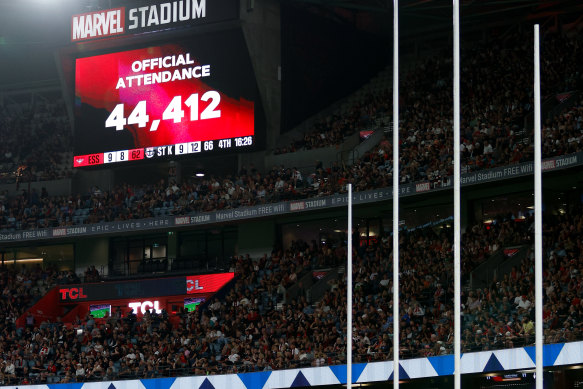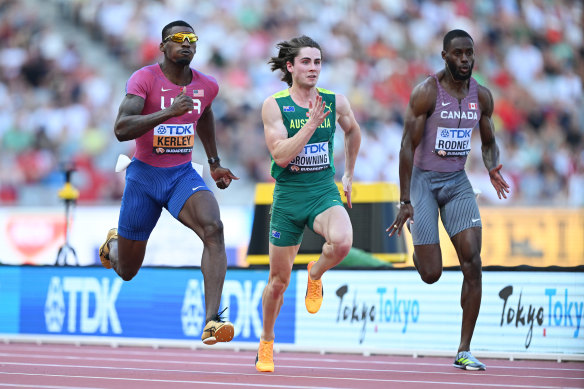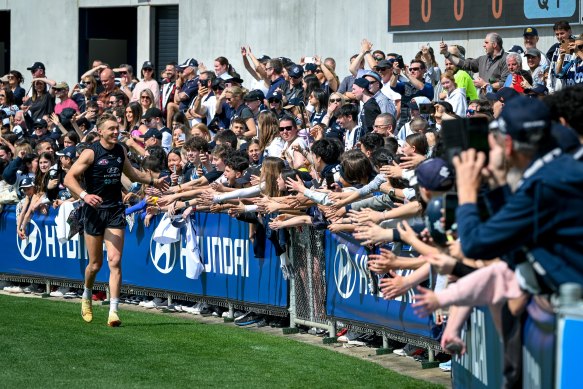By Peter Ryan
Marvel Stadium will not be used for AFLW matches in 2024 despite recently being upgraded with $225 million of state government funding, in part for “improved facilities to support professional women’s sport”.
It’s the biggest single publicly funded upgrade to AFL venues and club training bases since 2017 as state and federal governments have poured $450 million into the code’s facilities.
In addition, a further $15 million each has been promised for Hawthorn’s Dingley and Richmond’s Punt Road redevelopments.

Marvel Stadium has hosted one AFLW match for premiership pointsCredit: Getty
The Marvel Stadium upgrade, complete with a new-look stadium square featuring new bars, coffee spots and improved spectator amenities, was officially launched last month.
The occasion shone a light on the amount of Victorian taxpayer funds directed towards the league and AFL clubs to upgrade their stadiums and high-performance centres as other sporting bodies, including Olympic sports that rely heavily on government funding, battle for scarce dollars in a tight fiscal environment.
There were no AFLW games played at the AFL-owned Marvel Stadium in 2023 and two sources who attended a recent planning forum, but who were not authorised to speak publicly, confirmed to this masthead that the league would schedule women’s games at boutique stadiums again next season.
The AFL defended its decision, saying the changerooms at Marvel Stadium were used for two sold-out Matildas soccer matches in the past year as well as for female performers at concerts held at the venue since the redevelopment.
But AFLW commentator Chyloe Kurdas questioned why the AFL’s own stadium wasn’t being used to support the growth of the women’s game.
“It doesn’t make sense that the AFL’s own stadium, that has been so highly invested in through taxpayer dollars and the community, it doesn’t make sense that women will not be able to access it to play Australian rules football,” Kurdas said.
“The seating capacity of Marvel offers an opportunity to meet the needs and expectations of the AFLW fan base, particularly in high-value games like the finals, the AFLW finals or the AFLW grand final. It offers a real opportunity to help meet the community’s demand for those big marquee events.”

The Matildas have played two sold out matches at Marvel Stadium and Arsenal Women’s team will play a friendly in MayCredit: Getty Images
The league said it had been clear in its desire to grow AFLW sustainably and hoped Marvel Stadium would become a marquee venue for the competition in the future.
“We anticipate there will be a time in the future where Marvel Stadium will be used for AFLW marquee events, such as a grand final. Ultimately, we would all love the competition to be so big that we have no choice but to host more matches on the regular at the venue, but we must continue to sustainably grow the competition,” an AFL spokesperson said.
In January, the AFL also went into partnership with Development Victoria, the government’s property development arm, to discuss the potential redevelopment of the western side of the AFL-owned stadium that is a centrepiece of Docklands.
Athletes or stadiums?
Respected sports administrator John Wylie, who was the chair of the Australian Sports Commission for eight years, said much of the upgrading of facilities for women’s sport was necessary. But he said the boom came at the expense of Olympic and community sports and widened the gap between sport’s haves and have-nots.
“There is increasingly a sense of winner takes all, or winner takes most, economically in sports, and the AFL and the NRL are gapping a lot of other sports,” Wylie said.
“The Olympic sports are really facing a challenging future because they depend overwhelmingly on government funding, so it would be nice to see a greater focus on public investment on the sports that actually need the money.
“You would hope the public investment in sport wouldn’t reinforce what is increasingly a winner-takes-all economic situation that is emerging.”
Wylie was concerned that dominant sports attracted funding because of their blanket coverage, while organisations such as the Victorian Institute of Sport, which provides elite programs for potential Olympians, must fight for funding in this year’s state budget.

With the Olympics scheduled for Brisbane in 2032 debates about funding priorities will increaseCredit: Getty Images
“It would be nice to see a greater sense of priority of investment towards investing in athletes and participation in sport rather than what seems to be a very strong focus towards investing in stadiums,” Wylie told this masthead.
He worries that people are being attracted to elite sport stadiums to consume “burgers and beers” rather than participate.
“As a country, we have a health and obesity crisis, and yet the public investment in sport seems to be really focused on the consumption of sport as spectators and as entertainment as opposed to playing and being active.”
‘The bigger sports get bigger’
AFL clubs seem to be winning the hearts of politicians. In Geelong, $142 million was contributed to stage five of the Kardinia Park redevelopment, while about $70 million of state government funds were invested via other mechanisms in a high-performance centre – and now completed – upgrades at Essendon’s Hangar, the Bulldogs’ Whitten Oval and North Melbourne’s Arden Street.
A source with knowledge of the process, who wanted to remain anonymous in order to speak freely about how funding decisions are reached, said Geelong’s stadium build should be regarded differently to the other projects as they enjoyed the benefits of being in a marginal and regional seat.
Richmond and Hawthorn have also been promised $15 million each from the state government. The Tigers will upgrade Punt Road Oval and facilities supporting the Korin Gamadji Institute’s programs for Indigenous youth, while the Hawks will develop a high-performance centre at Dingley.
Collingwood completed an upgrade to their training base, including a sports medicine centre, in 2023 using a federal government grant of $15 million. Its completion so soon after the club withdrew its team from the Super Netball competition caused controversy on social media, but the club said the redevelopment met the funding’s objectives.
A feasibility study is also under way to determine whether Caulfield Racecourse is a suitable location for Melbourne to create a high-performance centre.

Ikon Park has had training facilities for both football programs upgraded and for business networkingCredit: Eddie Jim
Sports historian Greg Blood, who worked before retirement at the Australian Institute of Sport, said big professional sports have sophisticated lobbying mechanisms that assist them to make their case.
He first compiled a list of government funding of big sport in 2019 before updating it in 2024 to keep an eye on how public funding is impacting sport.
“The bigger sports get bigger and then the smaller sports are left behind, and they are totally reliant on government funding,” Blood said.
However, former Geelong president Colin Carter, who was a key architect of the AFL’s ground rationalisation policy, which resulted in more than 90 AFL games plus finals being played at the MCG and Marvel Stadium each season, takes a different tack.
“I have a big belief in stadiums. That is where people gather [and] whether you like it or not, footy plays an enormously important role in society and [it’s] mostly good. It brings people together,” Carter said.
“If you want to make the argument that a hospital wing or an infant health centre is more important then you would never build a museum, art gallery or a concert hall. At the end of the day, you have to say, ‘what are the things that add value to a community sense of excitement and belonging?’ Footy stadiums are up there.”
Carter said people needed to realise that funding for stadiums comes from a different bucket of money to the one allocated to education and health.
Grassroots funding
The Victorian government is cognisant of the importance of participation in local sport. As part of the 2018 deal to keep the AFL grand final at the MCG, the government committed $241.6 million to “upgrade facilities at suburban grounds, local clubs and high-performance centres across the state”.
Of that pool, $65 million went into the state netball and hockey centre, as well as $10 million to build the Melbourne Victory Football Academy and $12 million towards a rugby league hub that will house the proposed Melbourne Storm women’s team. That left about $110 million for suburban grounds and local clubs around Victoria, with $15 million of that dedicated to building female-friendly facilities.
The Victorian government also launched the community sports infrastructure loans scheme in that package, which provided eligible organisations access to low-interest rate loans of between $500,000 and $10 million to help build community sport and recreation infrastructure.
“We are supporting high-quality, accessible community sport infrastructure by investing more than $1.9 billion since 2014 to develop and upgrade facilities right across the state,” a Victorian government spokesperson said in a statement.
The AFL is also adamant that increasing participation is key to its plans. The commission has locked in funding for community sport as a percentage of revenue for the next 10 years.
“We provide 10 per cent of the AFL revenues to community [football], which is an estimated $1 billion invested over the next decade,” Dillon said at the SportNXT conference held in Melbourne earlier this month.
Two AFL sources, who wanted to remain anonymous as they were not authorised to speak publicly on the issue, defended the league’s approach, arguing the AFL puts broadcast revenue into community football, rather than seeking levies from participants to fund facilities.
They also argue that the AFL leverages its influence to build partnerships at all levels of government with the Australian Football Facilities Fund.
“[AFL clubs] understand the power they have in the community, and there is no better way to leverage this by utilising their training facilities for community groups. Each club has a different arrangement, but we have seen in more recent times those facilities being hubs for local community and at times other sports engagement. With all 18 clubs now having both AFL and AFLW programs, the facilities need to best reflect the amenities required for everyone to have the best experience possible,” a league spokesperson said.
Victorians are now waiting to see whether the big AFL build translates into a better sporting environment for all or a chance, as Wylie says, for more burgers and beers to be consumed.
“The Marvel Stadium redevelopment is delivering a first-class experience for sporting fans, concert-goers, function space users, and the athletes, both men and women who have used the facility over the last 12 months,” the AFL said.
But as the debate around government funding for the Tasmania Devils continues, the wait for AFLW games to be played at Marvel Stadium – which will host 43 AFL games in 2024 – continues.
Keep up to date with the best AFL coverage in the country. Sign up for the Real Footy newsletter.